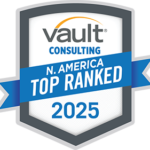
Interview - Alyza Keshavjee
Weaving Stories and Strategies: Alyza Keshavjee’s Journey
Veronica Moore, Kelsey Deutschmann — March 4, 2025
When Alyza Keshavjee began her career in strategy, she saw it as a great way to explore the vast possibilities within the business world. Flash forward to today, her career journey has taken her across the continent, spanning various roles and industries to Google, where she is Head of Consumer Insights and Executive Experiences.
I graduated with an undergraduate degree from Ivey and began my career at Boston Consulting Group (BCG). This role introduced me to strategy and management consulting, and I really enjoyed being client-facing – it was a fantastic place to start my career because it allowed me to explore various industries, interact with different clients, and gain insights into the world of business.
I then went on to pursue my MBA at Harvard Business School to deepen my understanding of management. It was an incredibly enriching time for me and served as a valuable step forward. After completing my MBA, I returned to Canada and took on roles that focused both on strategy and execution. These experiences were crucial post-MBA, and through them I was able to make the exciting shift to the tech sector.
Today, I am at Google, leading Consumer Insights and Executive Experiences. My role combines the consulting skills of storytelling and synthesizing data, with the technological aspect of integrating AI and advanced tools into our processes. It’s an essential combination for promoting Google’s products, and it’s a role I find both challenging and very rewarding.
Despite what Alyza may have envisioned at the beginning of her career, her path wasn’t quite a straight line. She credits her success as a leader today to the lateral moves she made and encourages others to embrace the “squiggly line”.
It’s very easy to graduate from business school and assume that your life is going to be a straight line up and to the right. That’s what schools promote – you hear about the profile of some CEO of some company who has climbed the straight ladder to the top. It’s a fantastic story, but I would argue that many of those people have actually done a squiggly roundabout line before they ended up on the top right that chart.
I’ve made a few lateral moves in my career, most notable for me was during my time at Manulife. I went from leading Global Strategy to then leading the Agile Transformation, which was not only a move in terms of level, but the roles also carried two fundamentally different job descriptions. For me this was less about the promotion and more about getting the execution experience. I got to build relationships with other business leaders, lead a team that was roughly three times my original size, and so many other things that I could check off my development list that I could not have done had I just stayed on one track.
It also opened doors to then pursuing a technology-centric role here at Google, a place where you are pushed to move laterally to experience different functions and understand the consumer from different angles. I think it’s the most natural way to grow your brain, which doesn’t naturally think just in one track all the time. To be more impactful and powerful as a leader, you really need to think about the sum of the parts across an organization. I’m a big fan of endorsing this kind of path – for the roles of the future, you won’t reach the top if you don’t do the squiggly line and move across an organization.
Like many consultants, Alyza learned the power of hypothesis-based thinking early. But once she learned how to communicate her findings in a cohesive story, she unlocked a skillset that will serve her the rest of her career.
The skill set that has stayed and served me well through my journey is hypothesis-based strategic thinking. It’s always helped me be focused about the story I’m going to tell and the message I need to land with target audiences.
Early on, I learned the value of forming a presumed answer or hypothesis before diving into work. This method helps structure my analysis and identify what needs to be true to validate my hypothesis. For example, if the goal is to triple profits, factors like customer demand and cost management must align.
I’ve found also that hypothesis-based thinking is crucial to be effective and persuasive. People don’t remember the 50 slides of analysis; they remember the story you tell. Humans can’t retain that much data, but a compelling story sticks with them. Leading with a hypothesis and weaving it into a narrative has opened many doors for me. When I stand on stage presenting or when I’m in front of clients, I always start with a story and encourage my team to do the same. Whether it’s personal or quick, the story is the thing they will remember.
Leveraging the right story has not only helped Alyza with her own ideas, but as a leader, it has helped her build stronger teams too.
Last year, my team went through a reorganization. It was a tough time, and as a manager, I had to lift my team’s spirits and figure out how to keep us moving forward. I had to set aside my emotions and think strategically about how to deliver the same business value with fewer people.
This led me back to using hypothesis-based thinking and storytelling to reshape our team’s structure, focus, and motivation. I thought about our vision for Google, our clients, and mapped out what needed to be true to get us there, which helped me redesign the team in ways I hadn’t thought possible.
We lost some specific skill sets, so I made a case to my manager about what we needed to double down on. Despite the reduced headcount, I positioned our team as AI power users and emphasized that everyone on my team needed to be trained in storytelling. While AI helped fill in some gaps, the storytelling component of my team’s skillset remained crucial because it’s something AI can’t replace.
The experience reinforced for me the importance of storytelling, especially in a time where it did not seem like the obvious solution. It helped me bring our team’s transformation to life and maintain our performance.
Developing strategies is only one part of the equation. By stepping into the role of an operator, Alyza discovered that one of the best ways of understanding how to make those strategies work is to roll up your sleeves.
A role in strategy is a phenomenal place to start your career, but as you grow as a business leader, it’s important to broaden your skill set across functions and operations. I’ve built many strategies, but sometimes you don’t know how to execute them until the rubber meets the road. Your budget might run out, or a new competitor might pop up – things change every day. By working as an operator, you get to see different processes and different projects, so if the time comes when you do want to become a more general management leader, you can say “I’ve been there, and I understand how that works.” It is then that you can speak to how the other functions would operate and how you would bring those functions together to deploy strategy.
Learning how to implement strategies on the fly and motivate people has been another huge learning experience for me. The strategy might still be sound but understanding how to inspire different types of people at various stages in their lives, and how to collaborate across an organization to achieve your goals, are incredibly challenging tasks. Regardless of the strategy, you really need to dive in and get your hands dirty to make it happen — the duality is crucial for rounding out your profile and growing as a leader.
In her role today, Alyza sees that the intersection of AI and creativity is enabling smarter strategies for Consumer Insights.
As someone who leads consumer insights and executive experiences at Google, I find the intersection of consumer insights and AI to be incredibly fascinating and transformative. In my role, I have the opportunity to blend strategic consulting skills with advanced technology, particularly AI, to drive meaningful recommendations and enhance our products.
Consumer insights are all about understanding the evolving needs and behaviors of our customers. With AI, we can take this understanding to a whole new level. AI allows us to analyze vast amounts of data quickly and accurately, uncovering patterns and trends that might not be immediately apparent. This helps us create more personalized and relevant experiences for our customers.
One of the main ways we do this today is through embedded AI in our products. For example, our digital marketing tools and devices like Pixel and Fitbit have AI capabilities built-in, making them more intuitive and user-friendly. However, thinking about the needs of the future, we are looking more to leverage applied AI to tackle more complex problems. By making use of the large data sets and more sophisticated models, we can predict customer behaviors and preferences, allowing us to serve them better and more efficiently.
However, it’s important to remember that while AI is a powerful tool, it cannot replace human creativity and storytelling. AI can assist in generating content and providing insights, but it is up to us to craft compelling narratives that resonate with our audience. The combination of AI-driven insights and human creativity is what truly drives success in today’s market.
While AI is reshaping the landscape of consumer insights and strategic decision-making by enhancing our ability to understand and serve our customers, it also requires us to remain curious, adaptable, and creative.
Alyza’s advice to future women leaders? Encourage the women on your team to own their accomplishments with confidence.
Throughout my career I’ve noticed that my male counterparts will make declarations like, “I’m the best at AI,” without much evidence. Meanwhile, I feel the need to present a spreadsheet, rationale, documentation, metrics, and project results to prove my expertise. Something I’ve learned from leading women at Google is that there are incredibly accomplished and smart people around us, often with multiple PhDs, and you would never know it. Women in strategy are incredibly smart, but strategy trains us to have a well-thought-out plan with data to back it up. Sometimes, though, it’s about leading with your story. Have a clear, concise pitch line for yourself and be ready to share it confidently.
Let someone push back and question you rather than always coming forth with all the reasons you’re credible. Be prepared to share your story succinctly and confidently. When I joined here, my manager told me to be ready to answer, “What’s your story? What do you do?” if I ever met the head of Google in the hallway. It’s not easy, but it’s important to know and articulate what you do really well. I like to tell people, “I build teams and products”. It’s simple, but I should probably say “I build teams and products exceptionally well.”




